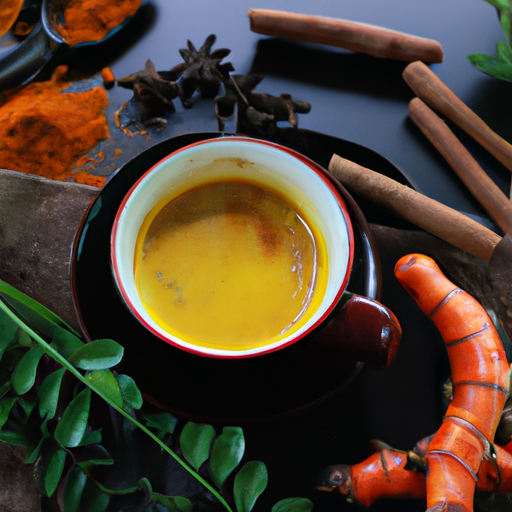I enjoy beginning my day with a cup of turmeric tea. It’s not only tasty and soothing, but turmeric also provides numerous health benefits.
From reducing inflammation to boosting brain function, this golden spice is truly a superfood.
If you’re interested in incorporating turmeric into your daily routine, making turmeric tea is a great place to start. It’s easy to make and can be enjoyed any time of day.
In this article, I’ll walk you through the steps to prepare a delicious and healthy cup of turmeric tea at home. So, let’s get started!
Key Takeaways
- Fresh turmeric root and organic honey are recommended for making turmeric tea, and using high-quality ingredients is important.
- Dry roasting the turmeric intensifies its taste and releases curcumin, and adding other spices like ginger, cinnamon, or cardamom can enhance the flavor and health benefits.
- Straining the tea is necessary to remove any remaining bits of turmeric or ginger, and different plant-based milk alternatives and sweeteners can be used.
- Turmeric tea can be enjoyed hot or cold, and the best time to drink it is a matter of personal preference. It has multiple health benefits, including anti-inflammatory and antioxidant properties, and has been linked to improved brain function, reduced risk of heart disease, and potential cancer-fighting properties.
Choose High-Quality Ingredients
To make the best turmeric tea, it’s important to choose high-quality ingredients. This includes fresh turmeric root and organic honey. Sourcing turmeric from a reputable supplier can ensure that you are getting the most potent and flavorful root.
Fresh turmeric root has a vibrant orange color and a strong aroma, indicating that it is rich in curcumin, the active ingredient responsible for its many health benefits. Using organic honey can enhance the flavor of the tea and provide additional health benefits.
Organic honey is free from pesticides and chemicals, making it a healthier alternative to processed sugar. By choosing high-quality ingredients, you can ensure that your turmeric tea is both delicious and nutritious.
Now, let’s move on to preparing the turmeric.
Prepare the Turmeric
To prepare turmeric tea, the first step is to properly prepare the turmeric. I always peel and grate fresh turmeric root, which can be found at many health food stores or Asian markets.
Then, I dry roast the turmeric in a pan for a few minutes to bring out its natural flavors and aromas. This process helps to intensify the taste and health benefits of the turmeric tea.
Peel and Grate the Turmeric
Before you begin peeling and grating the turmeric, take a moment to appreciate its vibrant color and earthy aroma. The turmeric peel has numerous benefits, such as containing antioxidants that help protect against cancer and reducing inflammation in the body. One of the different ways to use turmeric peel is to dry it out and grind it into a powder for use in cooking and seasoning.
To peel the turmeric, use a vegetable peeler or a small knife to remove the skin. Then, use a grater to finely grate the turmeric root. Be careful when handling the turmeric as it can stain clothing and surfaces. Once peeled and grated, the turmeric is ready to be used in making turmeric tea.
Moving on to the next step, we’ll dry roast the turmeric to enhance its flavor and make it easier to mix with other ingredients.
Dry Roast the Turmeric
Now it’s time to bring out the rich flavors of the turmeric by dry roasting it. This will also make it easier to blend with other ingredients in our recipe. Dry roasting turmeric is a simple process that involves heating the turmeric root in a pan until it becomes fragrant and slightly browned.
This process not only enhances the flavor of the turmeric but also increases its nutritional value. Benefits of dry roasting include the release of curcumin, the active ingredient in turmeric that has antioxidant and anti-inflammatory properties. Dry roasting also improves the bioavailability of curcumin, making it easier for our bodies to absorb.
Different ways to use roasted turmeric include adding it to soups, stews, and marinades, or using it as a spice in various dishes. Now that we have dry roasted our turmeric, it’s time to move on to the next step of brewing the tea.
Brew the Tea
First, let’s steep the tea bags in hot water to infuse the turmeric flavor. Don’t forget to give it a good stir!
Turmeric tea is known for its numerous health benefits, such as reducing inflammation and improving digestion. There are also many variations of turmeric tea, including adding ginger, cinnamon, or honey for added flavor and health benefits.
As the tea steeps, the bright yellow color of the turmeric will begin to infuse into the water. It’s important to let it steep for at least 5 minutes to ensure the full flavor and benefits are extracted.
Once the tea has steeped, it’s time to strain and serve.
Strain and Serve the Tea
To enjoy all the benefits of this deliciously soothing drink, all you need to do is strain the tea and serve it up hot. Straining techniques can vary depending on the tools available to you. Some people prefer to use a fine mesh strainer or cheesecloth to remove any remaining bits of turmeric or ginger, while others simply pour the tea through a regular strainer. Whichever method you choose, make sure to strain the tea directly into your serving cup.
Turmeric tea is packed with health benefits, including its anti-inflammatory and antioxidant properties. Regular consumption of the tea has been linked to improved brain function, reduced risk of heart disease, and even potential cancer-fighting properties.
So sit back, relax, and savor the warm, comforting flavors of turmeric tea while reaping the many benefits it has to offer.
Now that you know how to prepare and strain your turmeric tea, let’s move on to some tips for enjoying this delicious beverage to the fullest.
Tips for Enjoying Turmeric Tea
As an avid turmeric tea drinker, I’ve discovered a few tips that can enhance your enjoyment of this delicious beverage.
One of the easiest ways to mix things up is to experiment with different spices like cinnamon or ginger.
You can also try using different types of milk or sweeteners to find your perfect combination.
And don’t forget to consider whether you prefer your turmeric tea served hot or cold.
By trying out these different options, you can truly customize your turmeric tea experience to your liking.
Experiment with Different Spices
If you’re feeling adventurous, spice up your turmeric tea by experimenting with different flavors to add a little extra kick to your favorite drink. Let your creativity run wild and don’t be afraid to think outside of the box! Turmeric tea pairs well with a variety of spices, and you can create your own unique flavor combinations to suit your taste buds. Here are some spice combinations to try:
| Spice Combination | Health Benefits |
|---|---|
| Turmeric + Cinnamon | Anti-inflammatory, improves brain function |
| Turmeric + Ginger | Digestive aid, anti-inflammatory |
| Turmeric + Cardamom | Antioxidant, aids in digestion |
These spices not only add flavor to your turmeric tea but also come with their own set of health benefits. Adding a dash of cinnamon can improve brain function and reduce inflammation, while ginger aids in digestion and has anti-inflammatory properties. Cardamom is an antioxidant and can help with digestion as well.
Why not try out different spice combinations and see which one suits you the best? Once you’ve found your perfect blend, you can move on to the next step of trying different types of milk or sweeteners to make your turmeric tea even more delicious.
Try Different Types of Milk or Sweeteners
Get creative with your milk and sweetener choices to add a new dimension of flavor to your turmeric beverage. You can use traditional dairy milk or experiment with plant-based alternatives like almond, coconut, or oat milk. Each type of milk will bring its own unique flavor and texture to the tea, so feel free to try them all to find your favorite.
There are many alternatives to traditional sugar that can add a touch of sweetness without the added calories. Stevia, honey, maple syrup, and agave nectar are all great options to consider. Keep in mind that some sweeteners may have a stronger flavor than others, so start with a small amount and adjust to taste.
With so many different milk and sweetener choices to choose from, you can create a turmeric tea that is perfectly tailored to your taste preferences. Serve hot or cold, depending on your preference.
Serve Hot or Cold, Depending on Your Preference
Whether you prefer a soothing hot beverage or a refreshing cold drink, turmeric tea can be enjoyed in any temperature. The choice is yours, but there are pros and cons to consider.
Sipping on a hot turmeric tea can provide a comforting and warming sensation, especially during colder months. This temperature can also enhance the absorption of curcumin, the active ingredient in turmeric that provides its health benefits.
On the other hand, a cold turmeric tea can be a refreshing and energizing option during hotter months or after a workout. However, cold drinks can slow down the digestion process, potentially affecting the absorption of curcumin.
Ultimately, it’s important to choose the temperature that suits your preferences and needs.
As for the best time to drink turmeric tea, it’s a matter of personal preference. Some people prefer to have it in the morning as it can provide a boost of energy and aid in digestion. Others prefer to have it at night to promote relaxation and improve sleep quality.
Regardless of when you choose to consume it, make sure to enjoy it mindfully and reap the potential health benefits it has to offer.
Frequently Asked Questions
What are the health benefits of turmeric tea?
As someone who has been incorporating turmeric tea into my daily routine, I can attest to the numerous benefits it provides. From reducing inflammation to improving brain function, this powerful drink is a must-try. There are many recipes available online to make it at home.
Can turmeric tea be consumed by pregnant women?
Turmeric tea can be consumed by pregnant women, but safety concerns exist. Research findings suggest that excessive consumption may impact fertility and pregnancy outcomes. As with any supplement, it’s important to consult with a healthcare provider before use.
How many times a day can turmeric tea be consumed?
Daily consumption of turmeric tea is safe, but the recommended dosage should not exceed 3-4 cups per day. It is important to consult with a healthcare professional, especially if pregnant or taking medication.
Can I add honey or sugar to my turmeric tea?
Yes, you can add honey or sugar to your turmeric tea for sweetness. However, it’s best to use natural sweeteners like stevia or maple syrup to avoid the negative health effects of refined sugar.
How long does turmeric tea stay fresh?
Turmeric tea, like a flower, wilts with time. Properly storing it in a sealed container and refrigerating it can extend its shelf life up to 2-3 days. Discard if it smells sour or has mold.
Conclusion
In conclusion, preparing turmeric tea is a simple and beneficial way to incorporate this superfood into your daily routine. By choosing high-quality ingredients and properly preparing the turmeric, you can enjoy the full potential of its anti-inflammatory and antioxidant properties.
Remember to brew the tea for at least 10 minutes to allow for maximum extraction of the beneficial compounds. And don’t forget to strain the tea before serving to avoid any unwanted gritty textures.
With these tips in mind, you can enjoy a warm and soothing cup of turmeric tea, knowing that you’re nourishing your body with a powerful anti-inflammatory and antioxidant agent. So, go ahead and give it a try, your body’ll thank you!










